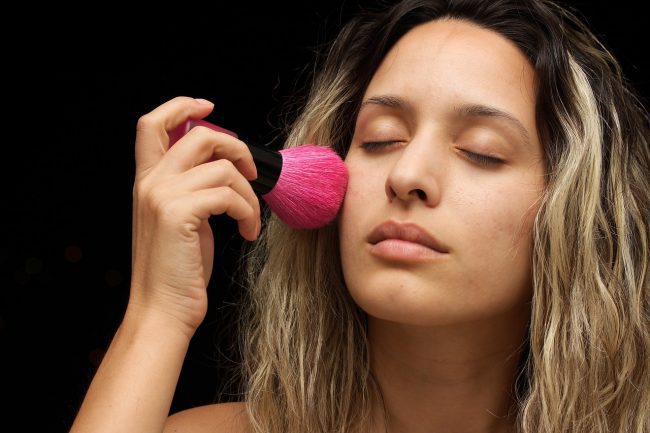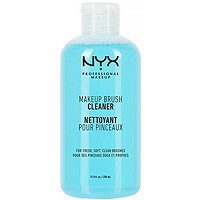
Our makeup holds plenty of secrets! It helps us put our best face forward, but what happens when it actually works against us?
Dirty makeup and contaminated brushes are a girl’s worst enemy. To avoid a dirty makeup disaster, it’s important to learn about the infections and conditions they can cause, along with what you can do to avoid an unhealthy situation.
Skin Breakouts
Noticing more blemishes than usual? While there could be other causes, like stress or hormones, dirty makeup is a common culprit. Make sure you’re always applying makeup to a clean face and removing it before bed, but most importantly, make sure you’re applying it with clean brushes and applicators.
Herpes
Once you contract the herpes virus, it stays in your body forever. You may never know if the friend you’re sharing that lip gloss with has the virus. Do yourself (and your lips) a favor and never share lip products. Because the herpes virus loves moist, dark environments, your lip gloss and lipstick provide the perfect living conditions. If you want to keep your lips free of painful and unsightly sores, keep your lip products to yourself and replace them as needed.
Fungal Infections
Fungal infections can occur anywhere on the body, including the face. If your brushes or makeup have been exposed to fungus, or developed it because of improper storage (such as damp products stored in a warm, dark drawer), the fungus can be transferred to your skin and wreak havoc. If you’re noticing strange rashes or dry, cracked, or sore skin, replace your makeup and thoroughly clean your brushes. Fungal infections can quickly turn serious, so seek medical attention if you don’t notice quick improvement.
Clogged Pores
Clogged pores can dull your complexion, speed up the aging process, and lead to serious breakouts. You have to be cautious when choosing makeup to avoid products that are more likely to clog pores. Hypoallergenic makeup always works best for me. But it’s not just about which products you use – it also comes down to the application process. Make sure your foundation isn’t old and always use clean sponges to apply it. Avoid using your fingers as this can transfer bacteria from your hands into the bottle. Clean your blush brush on a regular basis to avoid clogged pores on your cheeks.
Staph Infections
A staph infection is a blanket term for a multitude of diseases. A staph infection is a group of bacteria that can cause boils, cellulitis, and toxic shock syndrome, just to name a few.
It is possible to contract a staph infection through contaminated makeup. Though rare, these infections can lead to serious and permanent life-altering effects, like paralysis. Remember that these types of infections can’t be detected until they’re well underway, so it’s always wise to keep anything that encounters your face and mucus membranes as clean as possible, including makeup and brushes.
Pink Eye (Conjunctivitis)
Pink eye, also known as conjunctivitis, is a common infection of the inner eyelid and outer membrane of the eye itself. If you notice any swelling, soreness, or redness, seek medical attention for a diagnosis. Pink eye is easy to spread and can be contracted through dirty makeup. Never share mascara, eyeliner, or eyeshadow and make sure that your applicators have been recently cleaned. (Secret Tip: breast milk cures pink eye in 24-48 hours!)
E. coli
An E. coli infection is brought on by contact with feces of either humans or animals. Though it’s more common to contract it through food and water, it can also spread through makeup application. If your hands are contaminated, the bacteria can spread into your makeup bottles and tubes, where it can fester and then be spread onto your face. Though the infection usually clears on its own, there are serious symptoms that can arise, including fevers, vomiting, and dehydration.
Horror Stories
Imagine getting ready for the biggest day of your life – your wedding day. After your trial makeup session at a prestigious salon, you start to notice a little redness around your eye. The next day, the pain is incredible and there’s no way to disguise the swelling. It happened to Melissa Barter two weeks before she was supposed to walk down the aisle. Luckily, the infection cleared up before the big day, but she learned her lesson.
Kelly Birch had a similar experience. She never paid much attention to the age of her makeup until she noticed a rash starting to form on her right cheek. She gave it a few days, but it started to dry out and crack. When she headed to her doctor’s office where she found out that she had a fungal infection, most likely due to contaminated makeup.
On most days, you’ll be able to apply makeup without any adverse reactions. But the risk is real and the side effects can be serious, so take the proper precautions.

What Can You Do to Avoid Infections?
There are a few things you can do to prevent infections from your makeup and brushes. Remember to make the following part of your makeup routine:
Don’t apply makeup with your fingers.
Bacteria covers your fingers, even if you’ve just washed your hands. If you use your fingers to apply your makeup, you’re introducing bacteria to your tubes, palettes, and jars of product. These bacteria sit, where they can multiply and strengthen. The next time you go to use your makeup, you’ll be applying bacteria straight on your skin.
 Use clean applicators.
Use clean applicators.
Every time you use a makeup brush or applicator on your skin, it picks up skin cells and, you guessed it, bacteria. If left to be, serious bacterial colonies can build up and set up camp on your skin the next time you use a contaminated brush. At least once a month, wash your makeup brushes with makeup brush cleaner and warm water. Let them air dry completely before using them again.
Start and end with a clean face.
Wash your face before applying makeup to minimize the number of bacteria already on your skin. Always end your day with a thorough cleansing to minimize the number of bacteria left on your skin from makeup and your daily activities. This can help prevent makeup contamination from happening in the first place.
Dispose of makeup according to recommendations.
Depending on the type of makeup, you’ll want to dispose of it by its recommended expiration date. You won’t find one printed on your products though. Toss mascara after a 2-3 months and liquid foundations after 6 months. Powder based products can last up to two years. Liquid eyeliners should be disposed of after three months, while pencil eyeliners are safe for two years, if you’re the sole user. If a product ever has an odd odor or you fear it’s been contaminated, it’s smart to replace it immediately.
What Do the Experts Say?
According to Vivian Bucay, MD, a San Antonio-based dermatologist, there’s always the risk of spreading bacterial or viral infections through makeup. “We all harbor bacteria on our skin surface and these can contaminate our cosmetics.”
In other words, there’s no safe way to share makeup or apply it without taking the risk of spreading bacteria. But when you use proper techniques and put your health first, it’s easier to apply makeup in a safe manner that doesn’t just look great but keeps your skin happy and healthy.
The last thing you want is the infection ending you up in hospital, if you do there are services like “Hospital Stays” a online accommodation service to help take out the struggles of finding a hotel or serviced apartment.




